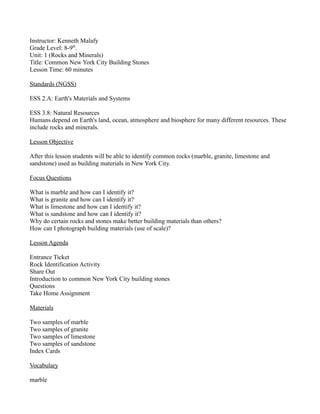
KenlessonsampleA
- 1. Instructor: Kenneth Malafy Grade Level: 8-9th . Unit: 1 (Rocks and Minerals) Title: Common New York City Building Stones Lesson Time: 60 minutes Standards (NGSS) ESS 2.A: Earth's Materials and Systems ESS 3.8: Natural Resources Humans depend on Earth's land, ocean, atmosphere and biosphere for many different resources. These include rocks and minerals. Lesson Objective After this lesson students will be able to identify common rocks (marble, granite, limestone and sandstone) used as building materials in New York City. Focus Questions What is marble and how can I identify it? What is granite and how can I identify it? What is limestone and how can I identify it? What is sandstone and how can I identify it? Why do certain rocks and stones make better building materials than others? How can I photograph building materials (use of scale)? Lesson Agenda Entrance Ticket Rock Identification Activity Share Out Introduction to common New York City building stones Questions Take Home Assignment Materials Two samples of marble Two samples of granite Two samples of limestone Two samples of sandstone Index Cards Vocabulary marble
- 2. limestone granite sandstone igneous metamorphic sedimentary scale Assessment Student's comments during the share out (informal) Student's Questions (informal) Take home assignment (formal) Lesson Entrance Ticket: “What building materials is your house/ apartment building made from? Why do you think the builders chose those materials?” Take 2-3 minutes to answer the question in your notebook or journal. Rock identification Activity The instructor will set up four tables. Each table will have two samples of the same rock. The students will be split into four groups. Each group will go to a sample table. They will have five minutes to describe the rock samples on that table (students can draw the sample). After five minutes, the groups switch tables. This process repeats until each group has surveyed each table. Share Out Students share their observations from the rock identification activity. Introduction to common New York City building stones Based on students comments during the share out, the instructor will take this time to address any misconceptions the students have. The instructor will also go over each rock sample from the rock identification activity and provide any information the students may have missed during the activity. The instructor will also describe the correct technique for photographing building stones, including the use of scale. Questions The instructor will introduce the take home assignment and review it with the students. Students will have a chance to ask any questions regarding the material covered in the lesson or the take home assignment.
- 3. Take Home Assignment Sheet Name: Date: Class: New York City Building Stones I. Go to a building and observe the stones it is constructed from. The building must be constructed from one of the stones introduced in class (marble, limestone, granite and sandstone). Note: the building does not have to be wholly constructed from the material, just part of it. It can be any building: your house, the school building, a local bank or even a subway station. II. Take at least four pictures of the building. One picture should be an overview and there should be at least two up close pictures of the stone with scale included. These pictures must be handed in with the assignment. III. Identify the stone in the picture. Is it igneous, metamorphic or sedimentary? What characteristics of the stone lead to your decision? IV. Why do you think the builders chose this type of stone? V. Extra Credit Take a picture of a second stone on the building and identify it.
- 4. Rubric No Mastery (55): Assignment is missing or incomplete Competent (75): Assignment is complete but: some of the information is wrong, the pictures are not clear and the work is sloppy and includes grammatical and spelling errors. Good (85): All the work is complete and mostly correct. The pictures are good and the work is neat, there are few grammatical or spelling errors Exemplary (95): All the work is complete and correct. The pictures are clear, the work is neat and there are very little grammatical mistakes or spelling errors.